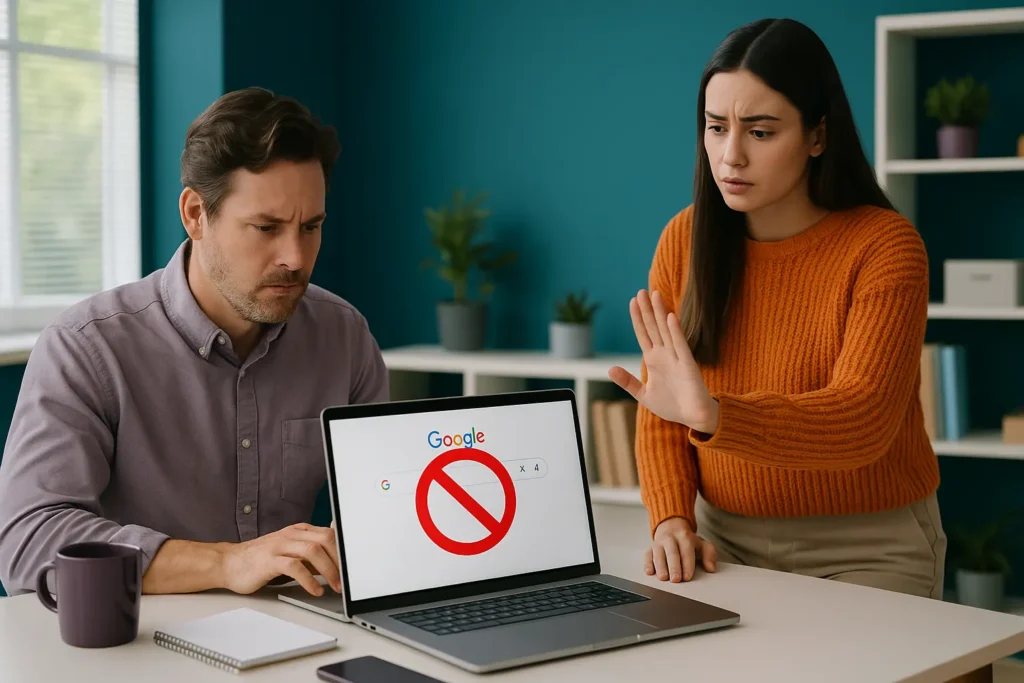Wondering how to remove a website from Google search results?
Everything you put online should be helpful, updated, and non-controversial. But the reality is that websites or specific pages sometimes need to be removed from Google search results. Whether due to outdated content, privacy concerns, legal issues, or brand reputation.
Since Google is the dominant gateway to web traffic, removing unwanted content from its index can be as important as removing it from the original site.
Because Google handles more than 90% of the global search engine market share. That is why being indexed by Google means visibility (and risks) for content worldwide.
How Google Search & Indexing Works (and What “Removal” Really Means)
Before going into removal methods, it’s important to understand what you’re asking Google to do:
- Google does not host content itself (unless it’s in Google’s own services). It crawls, indexes, and ranks content from websites across the web.
- Removing something from Google does not necessarily remove it from the web. If the page remains online, others might access it via direct URLs, social shares, or from other search engines.
- “Removal” in Google’s terms typically means: deindexing a URL so it no longer appears in search results (or making cached snippets disappear).
Because of this separation between web hosting and indexing, any removal strategy needs to combine actions on both Google’s side andon the original website (or via legal channels).
Common Reasons to Remove Content from Google
Here are some of the valid motivations:
- Privacy and personal data: Exposure of sensitive personal information (e.g. identity theft, doxxing, addresses).
- Reputation & branding: Outdated content, old business pages, negative past projects, or negative press you no longer want surfaced.
- Legal compliance/copyright: Claims of defamation, copyright violation, or regulation (GDPR “right to be forgotten,” CCPA, etc.).
- Sensitive or harmful content: Cases involving harassment, defamation, hate speech, or illegal content.
These motivations provide the justification for using the tools Google offers, or pursuing legal requests when necessary.
Methods to Remove Content from Google Search
Below are the main approaches. Combining technical, manual, and legal routes. Use the ones applicable to your case.
A. Google Search Console: Request Removal
If you own or control the site (or have GSC access):
- Temporary removal– Use the “Remove URLs”tool in Search Console to request a page to be temporarily hidden from search results (usually ~90 days).
- Clear cached versions– You can ask Google to remove the cached snapshot or snippet associated with that URL.
- Permanent de-indexing– For long-term removal, pair removal requests with server or meta changes (see next section).
This is often the cleanest path when you control the content or website.
B. Use “Noindex” Meta Tags & Robots.txt
To stop Google from indexing pages in the future:
- Add a <meta name=”robots” content=”noindex”>tag in the HTML head of pages you want excluded.
- Use HTTP headers (X-Robots-Tag) if you can’t modify HTML directly.
- Update your robots.txtfile to block crawling of certain directories or pages (though robots.txt is a guideline, Google may still index if linked externally).
Once Google recrawls the site and reads these tags, it should remove those pages from its index (assuming no conflicting directives).
C. Google’s “Remove Outdated Content” Tool
When the content has already changed or been deleted but still appears in Google’s cache:
- Use the Google Remove Outdated Content request tool to ask for the removal of the cached snapshot and snippet.
- This is useful when the live page has already been edited but Google still shows the old version.
Note: This route does notremove the original content. It only affects what Google displays.
D. Legal / Formal Requests to Google
If the content breaches the law or violates policy:
- DMCA takedown requests(for copyright infringement). Google has a dedicated process and transparency reportingon such requests.
- Privacy / defamation / “Right to be Forgotten”requests (e.g. in the EU). Google evaluates these under applicable law.
- Government or court-ordered removals: Courts, governments, or authorized parties can submit legal requests to Google to deindex content. Google publishes data on such requests in itsTransparency Report.
When using legal requests, Google sometimes notifies the website owner (when feasible) but may withhold details to protect requesters’ privacy.
Best Practices for Website Owners & Content Stewards
To ensure removals are effective and don’t create future issues:
- Use 301 redirectsfrom removed or outdated pages to related content so users and bots aren’t met with dead ends.
- When possible, updateold content instead of deleting outright (improves user experience and retains link equity).
- Maintain consistent site hygiene: limit orphaned pages, monitor which URLs are crawled, and clean up legacy subdomains.
- Periodically audit your site for sensitive pages or content that shouldn’t be indexed.
By keeping your site organized and indexed content intentional, you reduce the need for emergency removals.
Common Mistakes & Pitfalls to Avoid
Here are some of the most common pitfalls to watch out for:
- Assuming removal is instant: Google may take days or weeks to recrawl and deindex content.
- Only blocking crawlers(robots.txt) without using noindex. The page can still appear in search results if Google finds external links to it.
- Removing without redirecting or cleaning internal linksleads to broken links (404s) or lost traffic.
- Ignoring backlinks: external links may persist ad send traffic to the page unless those links are fixed or taken down.
- Expecting Google to delete the content itself: Google can only deindex; removing the actual page requires action by the hosting website or rights holders.
How Long Does It Take & What to Expect
One of the most frequent questions people ask is, “How fast will Google remove my content?” The answer depends on the method you use and Google’s crawl schedule.
Here’s what you should realistically expect:
- After you make changes (e.g. add noindex, issue removal request), Google needs to recrawl and reprocessthe URL — this can take anywhere from a few days to several weeks depending on site authority and crawl schedule.
- For legal requests, the review process adds additional time.
- Even after removal, cached snapshots or third-party archives (e.g. the Wayback Machine) may retain older versions — you may need to take additional steps with those archives.
Example Use Cases & Decision Matrix
| Scenario | Best Removal Method(s) | Notes |
| You control the site and page | Search Console removal + noindex+ redirect | Clean, full control |
| Page already deleted but still shows in Google | Remove Outdated Content tool | Only affects the Google cache |
| Content is defamatory or violates privacy | Legal / privacy request | Subject to jurisdiction & law |
| Copyright infringement | DMCA request | Must provide proof of rights ownership |
| A subdomain or old brand site | Use redirects + noindexon the sitewide level | Gradual phase-out strategy |
Use this matrix to pick the right tool or combination of tools for your situation.
Wrap Up
Removing a website or webpage from Google search results is a nuanced process; it often requires a combination of technical measures, legal requests, andongoing site maintenance.
The best outcomes happen when:
- You control or have access to the site (so you can add noindex, redirects, or remove content).
- You use Google’s removal tools wisely (temporary removals, outdated content requests).
- You leverage legal pathways when content violates rights or laws.
- You maintain good content hygiene to minimize the need for removal in the future.
If you have multiple URLs, an entire subdomain, or a complicated legal scenario, it’s wise to get expert help from a Sacramento SEO agencylike Sierra Exclusive.
Our SEO experts can can assist you with the following:
Book a consultationwith us today to map out a strategy and action for your business website.




